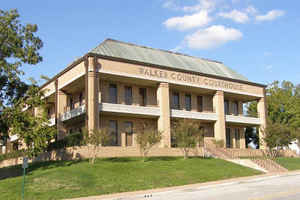Texas Counties
Texas is divided into two hundred and fifty-four counties, more than any other state. Texas was originally divided into municipalities, a unit of local government under Spanish and Mexican rule. When the Republic of Texas gained its independence in 1836, there were 23 municipalities, which became the original Texas counties. Many of these would later be divided into new counties. The most recent county to be created was Kenedy County in 1921. The most recent county to be organized was Loving County in 1931Walker County, Texas
Walker County Education, Geography, and History

Walker County is a county located in the east central section of the state of Texas. Based on the 2010 census, its population was 67,861.
Its county seat is Huntsville. Initially, Walker County was named for Robert J. Walker, a legislator from Mississippi who introduced into the
United States Congress the resolution to annex Texas. Walker later supported the Union during the Civil War and earned some enmity. In order
to keep the county's name, the state renamed it for Samuel H. Walker, a Texas Ranger and soldier in the American Army.
Walker County is part of the Huntsville, TX Micropolitan Statistical Area as well as the Houston-The Woodlands, TX Combined Statistical Area.
Etymology - Origin of Walker County Name
Samuel Hamilton Walker, a Texas Ranger and soldier in the Mexican-American War
Demographics:
County QuickFacts: CensusBureau Quick Facts
Walker County History
Walker County is a county located in the US state of Texas. The 2006 Census estimate placed the county's population
at 63,304. Its county seat is Huntsville.
Initially, Walker County was named for Robert J. Walker, a legislator from Mississippi who introduced into the United
States Congress the resolution to annex Texas. However, Walker later supported the Union during the Civil War; thus, in
order to keep the county's name from being changed, it was renamed for Samuel H. Walker, a Texas Ranger and soldier in
the American Army.
Handbook of Texas Online
In the years prior to Texas independence, the area was governed by the Municipality of Washington, which became
Washington County during the Texas Revolution. In 1837 the First Congress of the
Republic of Texas included the area of present Walker County in Montgomery
County when that county was carved from Washington County. Steamboat navigation of the Trinity River spurred the
earliest burst of commerce in the county. In 1838 James DeWitt established the port town of Cincinnati, which soon
became the leading regional commercial center, partly because it was on the stage road connecting
Washington-on-the-Brazos and Nacogdoches. Cotton and other agricultural products were taken down this highway to
Cincinnati, then transported down the Trinity River to the Port of Galveston. In April 1846 the First Legislature of
the new state of Texas established Walker County and designated Huntsville the seat of government. The county's
first officials included Milton Estill as chief justice, Isaac McGary as county
clerk, and William Reeves as sheriff. James Mitchell, Benjamin W. Robinson, Elijah S. Collard,
and D. J. Tucker, the county commissioners, held their first session on July 27, 1846, in Huntsville. A site for the
courthouse was donated by Pleasant Gray and his wife, and Henry Sheets and his spouse provided the property for the
jail. The new jail was completed in 1847, and the first courthouse a year later. By 1847 there were 2,695 people
living in the area. In 1848 the county became the designated site for what became the Texas State Penitentiary at
Huntsville, which began operating in 1849. By 1850 the population of Walker
County had increased to 3,964, including 1,301 slaves. No free blacks lived in the area. Farms in the county
encompassed 146,000 acres that year; of these, 12,000 were classified as "improved," and local farmers produced
102,000 bushels of corn and 1,873 bales of cotton. Oats, beans, and sweet potatoes were also grown. Livestock was an
important part of the economy at that time; almost 4,300 milk cows and more than 18,000 other cattle were reported
that year More at
John Leffler, "WALKER COUNTY," Handbook of Texas Online (http://www.tshaonline.org/handbook/online/articles/hcw01),
accessed January 24, 2016. Uploaded on June 15, 2010. Published by the Texas State Historical Association.
Geography: Land and Water
As reported by the Census Bureau, the county has a total area of 801 square miles (2,076 km2), of which, 787
square miles (2,039 km2) of it is land and 14 square miles (37 km2) of it (1.75%) is water.
Neighboring Counties
Bordering counties are as follows:
- Houston County (north)
- Trinity County (northeast)
- San Jacinto County (east)
- Montgomery County (south)
- Grimes County (west)
- Madison County (northwest)
Education
Sam Houston State University is located in Huntsville.
School districts serving portions of the county include:
Huntsville Independent School District
New Waverly Independent School District
Richards Independent School District (portion)
Trinity Independent School District (portion)
The Gulf Coast Trades Center, a charter school, is in an unincorporated area of the county.







